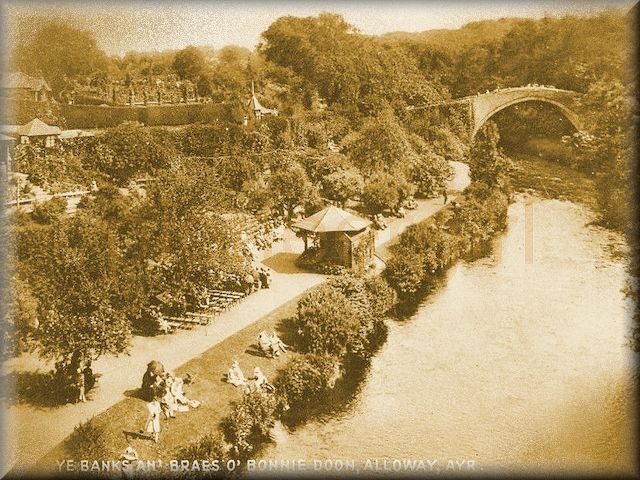“Bonny Doon”

 Laura had never been so happy, and for some reason she was happiest of all when they were singing, ‘Ye banks and braes of Bonny Doon’…– By the Shores of Silver Lake, Chapter 22, “Happy Winter Days”
Laura had never been so happy, and for some reason she was happiest of all when they were singing, ‘Ye banks and braes of Bonny Doon’…– By the Shores of Silver Lake, Chapter 22, “Happy Winter Days”
 Pa rosined the bow, tucked the fiddle under his chin, and touched the strings. He looked at Laura. — ‘Play ‘Bonnie Doon,’ Laura said, and Pa played and sang… — The Long Winter, Chapter 22, “Cold and Dark”
Pa rosined the bow, tucked the fiddle under his chin, and touched the strings. He looked at Laura. — ‘Play ‘Bonnie Doon,’ Laura said, and Pa played and sang… — The Long Winter, Chapter 22, “Cold and Dark”
Bonny Doon (often “Bonnie Doon” or “Bonie Doon”) was originally an 1792 song by Robert Burns first titled “The Banks o’Doon.” The song tells of a tragic love affair (not one of the poet’s): a respected young lady gave birth to a child out of wedlock, was forsaken by her town and people, and died of a broken heart. In March 1791, Burns wrote that he had “this evening sketched out a song” to be sung to the tune of a “reel of which I am very fond,” called “Ballandallach’s Reel” in some collections and “Camdelmore” in others. The song was reworked in 1792 and first published in 1800. Burns often referred to the song as “Ye Banks and Braes o’ Bonnie Doon.” The river (doon) in the song flowed from Loch Doon and entered the Firth of Clyde about ten miles west of where Burns was born. In the earliest publications, “Doon” is written as “Donn”, and the castle of Donn (or Donne) was for some time the residence of Mary Stuart, Queen of Scotland, and it was often connected with song and legend.
Robert Burns (1759-1796) was born near Ayr, Scotland, the son of a poor farmer. As a teenager, “Rabbie” began writing verses in Scots dialect and received recognition for his writing. He unsuccessfully labored as a farmer until circumstances (he fathered at least nine children by five different women) made him decide to move to Jamaica. In order to secure money for the trip, he published a book of his verses at Kilmarnock in 1786. It was so highly regarded that he was asked to come to Edinburgh and publish another edition of the work.
This was the turning point in Burns’ life. In Edinburgh, he was among society, riches, and learning, and both his poetry and conversational skills were much in demand. Hard work and hard drink led to health problems, however, and he died at age 37. Today, Burns is the Official Bard (poet) of Scotland, and on his January 25th birthday each year, Scots around the world celebrate with a Burns Night Supper. Mary Ingalls was such a fan of Robert Burns that at her graduation from the Iowa College for the Blind, she performed a Burns essay, “Bide a Wee and Dinna Weary.”
Ye banks and braes o’ bonnie Doon,
How can ye bloom sae fresh and fair?
How can ye chant ye little birds
And I sae weary, fu’ o’ care.
Thou’ll break my heart, thou warbling bird.
That wantons thro’ the flowering thorn
Thou minds me o’ dearted joys
Departed never ti return.
Oft hae I roved by bonie Doon
Tae see the rose and woodbine twine
Ilka bird sang o’ its love
And foldly sae did I o’ mine.
Wi’ lightsome heart I pu’d a rose
Fu’ sweet unpon its thorny tree
And my fause lover staw my rose
But ah! he left the thorn wi’ me.
BONNY DOON (from By the Shores of Silver Lake)
Ye banks and braes of Bonny Doon,
How can ye bloom sae fresh and fair?
How can ye chaunt, ye little birds,
And I sae weary, full of care?
For reference — bonie: beautiful; braes: hills; fause: false; staw: stole
(by Robert Burns)
Ye flowery banks o’ bonie Doon,
How can ye blume sae fair?
How can ye chant, ye little birds,
And I sae fu’ o’ care?
Thou’ll break my heart, thou bonie bird,
That sings upon the bough:
Thou minds me o’ the happy days
When my fause luve was true.
Thou’ll break my heart, thou bonie bird,
That sings beside thy mate:
For sae I sat, and sae I sang,
And wi’ na o’ my fate.
Aft hae I rov’d by bonie Doon
To see the woodbine twine,
And ilka bird sang o’ its luve,
And sae did I o’ mine.
Wi’lightsome heart I pu’d a rose
Upon a morn in June,
And sae I flourish’d on the morn,
And sae was pu’d or’ noon.
Wi’ lightsome heart I pu’d a rose
Frae aiff its thorny tree,
And my fause luver straw my rose,
But left the thorn wi’ me.
CLICK HERE to listen.
Click on the above images to view view a copy of sheet music of “Bonny Doon.”
This music is archived in the Lester S. Levy Collection of Sheet Music, part of Special Collections at the Milton S. Eisenhower Library of The Johns Hopkins University.
The collection contains over 29,000 pieces of music and focuses on popular American music from 1780-1960.

“Bonny Doon” (SSL 22; TLW 22)
“Ye banks and braes of Bonny Doon…”



